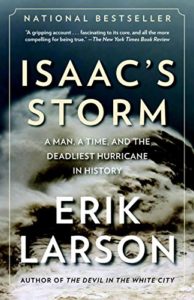
Isaac’s Storm is a detailed account of a massive hurricane that struck the coast of Texas in September 1900. The storm wreaked havoc across a wide swath of the country but devastated one city in particular. In Larson’s words, “Galveston became Atlantis.”
Estimated reading time: 4 minutes
The deadliest hurricane in history?
The book’s subtitle refers to the unnamed storm as “the Deadliest Hurricane in History,” but that’s far from true. Individual cyclones (simply another name for hurricanes) that have struck the coast of Bengal and Orissa in northeastern India (and now Bangladesh) have killed as many as 100,000 people. Several have felled tens of thousands in modern history. The storm that virtually destroyed Galveston in 1900 caused fewer than 10,000 deaths (probably no more than 8,000). In truth, then, “Isaac’s storm” was the deadliest only in US history. But publishers have a way of dramatizing books’ content with sensational titles. Clearly, they sell more books that way.
Isaac’s Storm: A Man, a Time, and the Deadliest Hurricane in History by Erik Larson ★★★★☆
Galveston today is a city of fewer than 50,000 inhabitants, but in 1900 it “stood on the verge of greatness. If things continued as they were, Galveston would soon achieve the stature of New Orleans, Baltimore, or San Francisco. . . [T]hey were in a winner-take-all race against Houston, just fifty miles to the north.”
Who was Isaac, and why was it his storm?
The Isaac of the title was Dr. Isaac M. Cline, the chief weatherman in Texas. He was also a physician specializing in the effects of weather on human health. Isaac had risen through the ranks of the Weather Service because he had proved to be one of the most diligent and perceptive forecasters in the bureau. In the years following the Galveston hurricane, Isaac spoke and wrote widely about having saved thousands of lives by warning of the danger before the most destructive waves hit the city. In fact, as Larson makes clear, he did no such thing. However, he had indeed perceived that a storm was coming, and even defied orders from Washington to spread the word. Unfortunately, he had no clue that the storm was a hurricane that would blast through Galveston with sustained winds of 180 miles per hour and gusting to more than 200 miles per hour.
In Isaac’s Storm, Larson skillfully intersperses a sketch of Isaac’s life with a detailed portrait of the hurricane. Originating in Western Africa and making its way across the Atlantic to the Caribbean, the storm had gathered such force that Cuban meteorologists identified it as a hurricane shortly after it arrived in the region. Sadly, the director of the US Weather Service was a racist and obsessed with control, and he had prevented the Cuban forecast from being transmitted because he thought the Cubans inferior. Later, the director went even further, refusing to acknowledge Isaac’s warnings about the coming storm. (In years afterward, the director shamelessly claimed loudly and often that he had actually issued warnings about the devastating storm.)
About the author
Erik Larson is unquestionably one of the most talented and accomplished nonfiction authors at work in the US today. He is probably best known for his runaway bestseller, The Devil in the White City, which won numerous awards, including an Edgar in 2004.
For related reading
I’ve also reviewed three other excellent books by Erik Larson:
- In the Garden of Beasts: Love, Terror, and an American Family in Hitler’s Berlin (Why the U.S. failed to speak out against the rise of Hitler’s Germany)
- Dead Wake: The Last Crossing of the Lusitania (When a U-boat sank the Lusitania and changed history)
- The Splendid and the Vile: A Saga of Churchill, Family, and Defiance During the Blitz (An intimate view of Winston Churchill in WW2)
You might also enjoy Science explained in 10 excellent popular books.
If you enjoy reading nonfiction in general, you might also enjoy:
- Great biographies I’ve reviewed: my 10 favorites
- My 10 favorite books about business history
- 20 top nonfiction books about history
And you can always find my most popular reviews, and the most recent ones, on the Home Page.



























